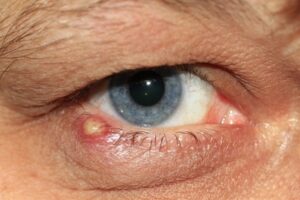Dry eyes, eye allergies, and eye infections can be difficult to differentiate between despite being different eye problems. This is partly due to the fact that they share similar symptoms. Another problem is that one condition can cause another, as is the case with dry eyes and eye infections.
In order to tell the difference between dry eyes, eye allergies, and eye infections, you need to focus on what makes them unique. Dry eyes and eye allergies can both result in dry, itchy eyes, but eye allergies may also include sneezing and a runny or stuffy nose. Eye infections can affect your eye’s appearance and can be accompanied by fever.
To learn the difference between the three, we’ll dive deep to look at their symptoms, causes, and treatments. Keep in mind that your eye doctor will be the best judge of your eye condition. They will be able to properly diagnose your condition and prescribe the best treatment.
Dry Eyes
Dry eye is a common and chronic condition where you aren’t able to produce quality tears to maintain the health of your eyes. Tears are one of the most important factors in eye health and vision health. They’re essential in keeping your eyes lubricated, keeping the surface of your eye clear, and preventing eye infections.
Symptoms of Dry Eyes
The symptoms of dry eyes can range from the annoying to the dangerous. On the less dangerous end of the spectrum, your eyes may feel gritty and irritated, or as if something is in your eye. On the other end, you can experience excess watering or even blurred vision, which can put yourself and others in danger when engaging in activities like driving.
In extreme cases, you may develop advanced dry eyes. This condition is particularly dangerous since it can result in impaired vision caused by damage to the front surface of your eye.
Causes of Dry Eyes
Dry eyes are the result of an imbalance between tear production and drainage. When the condition occurs, you are either not producing enough tears or the tears you do produce are low-quality.
Other factors can cause dry eyes, as well. These can include:
- Your age
- Your sex
- Medications you may be taking
- Medical conditions you may have
- Environmental conditions
- Excessive screen time
One of the most common causes of dry eyes is looking at a computer screen for extended periods of time. People tend to not blink as much when staring at screens, which prevents the normal spreading of tears over the eye. Make sure you’re taking breaks, occasionally looking into the distance, and blinking regularly to keep your eyes lubricated.
Your dry eyes may be caused by one or a combination of factors. Talk with your doctor to determine which are at the root of your dry eyes and how to best treat them.
Treating Dry Eyes
When treating dry eyes, the primary goal is to repair or retain your eyes’ ability to produce a healthy amount of quality tears. This will help to increase moisture, alleviate discomfort, and maintain their overall health.
This can be accomplished in a variety of ways, such as:
- Increasing your production of tears
- Adding tears to your eyes
- Conserving the tears you’re already producing
- Treating your eyelids or eye surface for inflammation
Some options are more demanding than others. Talk to your doctor to determine which option is the best for your dry eyes.
Eye Allergies
You may only associate allergies with sneezing and having a runny nose. However, allergies can also result in itchy, swollen, irritated eyes. Allergies aren’t just limited to springtime, either. Eye allergies can be triggered by dust mites, feathers, pet dander, as well as pollen and other outdoor allergens.
Symptoms of Eye Allergies
Your allergic response can vary from allergen to allergen. For instance, you may immediately respond to pollen, but it may take a few days for pet dander to catch up with you. Regardless of how long it takes, keep a lookout for these symptoms to see if your eye allergies are acting up.
- Eyes that are red and irritated
- Uncontrollable tearing or runny eyes
- Sensitivity to light
- Itchy eyes
- Swollen eyelids
Don’t forget to look out for other allergy symptoms. While they may not affect your eyes, sneezing and stuffy or runny noses are classic allergy symptoms that shouldn’t be ignored.
The Cause of Eye Allergies
Eye allergies are the result of a confused immune system. Your body is reacting to harmless matter like pollen and dust as if they were dangerous. To fight what it perceives as an intruder, your body releases histamine to combat the usual inflammation and swelling. The result is the blood vessels in your eyes swelling up, causing them to become itchy, irritated, and teary.
Treatments for Eye Allergies
There are plenty of options available to treat your eye allergies. They come in all forms, including over-the-counter pills and eye drops. Antihistamines are another great option. Antihistamines work by blocking the histamine your body releases and preventing your eyes from becoming irritated.
In the end, the best way to treat eye allergies is to prevent them before they start. Learn what triggers your allergies and talk to your doctor about the best treatment. They can also give you advice on when to begin treating your allergies before they have a chance to flare up!
Eye Infections
Eye infections are so varied that they can be difficult to self-diagnose. Another difficulty is that they can have similar symptoms to dry eye and eye allergies. It’s best to talk to your doctor if you suspect that you have an eye infection. They’ll be able to tell if it’s an infection, which part of your eye is infected, and prescribe the best treatment.
Symptoms of Eye Infections
Despite having similar symptoms to other eye problems, eye infections have others to warn you that something is seriously wrong. These are often changes in your eye’s appearance. Keep an eye out for:
- Crust developing around your lids and eyelashes
- Pink discoloration in the white part of your eye
- Any kind of abnormal discharge coming from your eye
- Swollen eyelids that are purple or red
- Enlarged lymph nodes near your ear
- Fever
Causes and Treatments of Eye Allergies
It’s extremely important that you see your doctor if you think you have an eye infection. The cause and treatment of your eye infection are determined by the part of your eye that’s infected – the cornea, eyelid, or conjunctiva. From there, they will determine what it’s infected with.
Conclusion
Dry eyes, allergies, and eye infections all have distinct symptoms and can be easy to self-diagnose. However, the similarities between them may lead you to misdiagnose yourself and apply the wrong treatment. That’s why your best bet for diagnosis and treatment is to see your doctor. They’re specifically trained in diagnosis, treatment, and guiding you through the recovery process.
Located at 10904 Spring Bluff Way off Hardin Valley Road, Hardin Valley Eyecare & Optical has provided the highest quality vision care products and trusted optometry services to our patients in Knoxville and the surrounding areas since 2009. Our eye care professionals are dedicated to providing exceptional personal service to each and every person who walks through our door. Call us at (865) 409-1253 or contact us to schedule your appointment.





